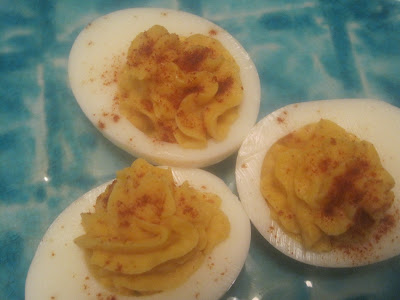I'm not a huge fan of sweet potatoes, but they've redeemed themselves in my book for this use. While in Austin a few weeks ago I had some sweet potato gnocchi that were insanely delicious; they were fluffy and super buttery and rich. Then I got a couple sweet potatoes in my CSA box around Thanksgiving so set off to make my own sweet potato gnocchi.
I substituted sweet potatoes for regular potatoes in my great-grandmother's gnocchi recipe and served them in a meat ragu which I'll also provide the recipe for here. Making everything is a big endeavor, but so worth it. I also discovered that the gnocchi in the meat ragu freezes quite well; just defrost and bake to before serving. As an easy alternative you can skip the meat ragu and toss the gnocchi in browned butter with fresh sage.
Ingredients:
I substituted sweet potatoes for regular potatoes in my great-grandmother's gnocchi recipe and served them in a meat ragu which I'll also provide the recipe for here. Making everything is a big endeavor, but so worth it. I also discovered that the gnocchi in the meat ragu freezes quite well; just defrost and bake to before serving. As an easy alternative you can skip the meat ragu and toss the gnocchi in browned butter with fresh sage.
Ingredients:
- Meat ragu (recipe to follow)
- 2 large sweet potatoes
- 1 stick butter, melted
- salt
- approx 3 cups of AP flour
- 2-3 egg yolks
- Parmesan, shredded
- Wash the sweet potatoes and piece a few times with a fork. Place in oven at 400 for 45 minutes or until cooked through. Remove from oven and allow to cool enough to handle.
- Cut lengthwise and remove insides from skin. Put potato through ricer to get smooth texture.
- Place potato in large bowl and mix in melted butter and add 1 tablespoon of salt.
- To make dough, start by combining the potato with an equal amount of flour (So if you have 2 cups potato use 2 cups of flour). I used a stand-up mixer with the paddle attachment and then dough hook, but you can use your hands too, but don't over mix.
- Once flour and potato is combined add 1 egg yolk and mix until combined. Continue to add 1 egg yolk at a time until dough comes together. Usually it takes 2-3 yolks. The dough should be spongy and just dry enough to handle. You can add more flour if dough is too wet.
- Place dough onto floured surface and shape into ball. Cut into 8ths so it's easy to handle.
- Take each piece of dough and roll into long 1 inch thick rope. Then off 1 inch long pieces from rope. Dust pieces of gnocchi with flour. Using your thumb, roll each piece across a gnocchi board or around a fork and place on dusted sheet pan.
- Once all gnocchi are created, bring a large pot of salted water to rolling boil. Then gently place gnocchi into water in batches so they don't crowd and stick together. Cook for 4 minutes and taste gnocchi to make sure cooked properly and adjust cooking time if needed. Remove cooked gnocchi from water and place directly into warm sauce as others cook.
- Serve immediately, sprinkled with Parmesan. Or refrigerate/freeze in sauce and reheat by baking in covered dish.
Meat Ragu Ingredients:
- 1 onion, chopped
- salt and pepepr
- 2 tablspoons olive oil
- 4 cloves garlic, chopped
- 2 tablespoons dried oregano
- 1/2 lb ground beef
- 1/2 lb Italian sausage, removed from casing
- 2 cups red wine (Merlot, Zin, Sangiovese, etc)
- 1-28oz can of tomato puree
- 1-6oz can of tomato paste
- Heat olive oil in large pot. Add onion and garlic, season generously with salt and pepper and cook until begins to soften.
- Add oregano and cook for 2 more minutes.
- Add beef and sausage. Break up into small pieces and cook through.
- Pour in wine, tomato sauce, and tomato puree, and mix to combine.
- Using immersion blender, puree only slightly (about half of sauce).
- Allow ragu to simmer for 2 hours. It should be thick, but if it thickens too much add a little water.
.JPG)













